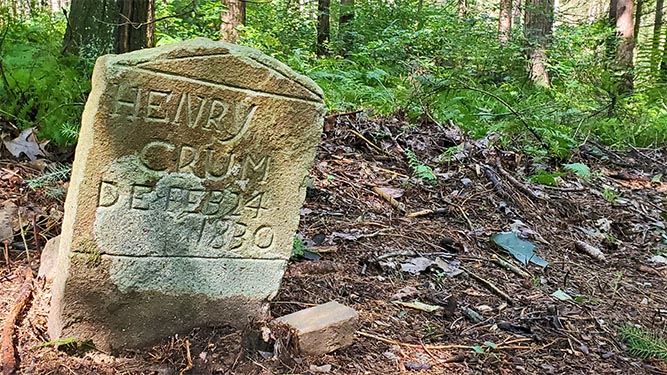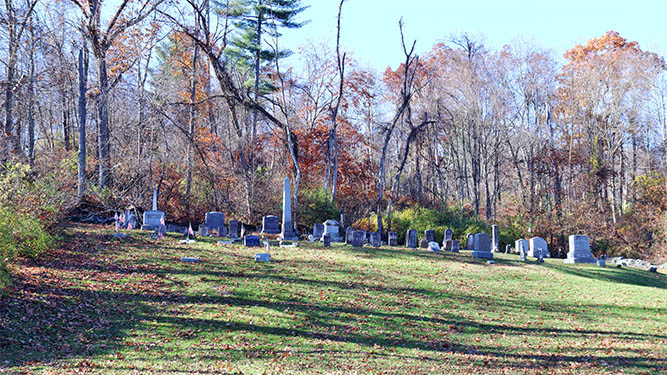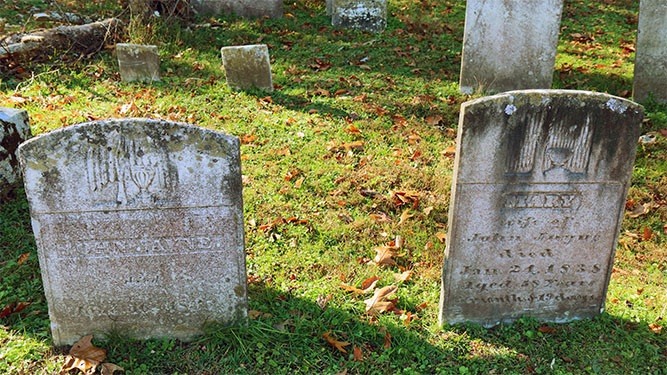As we prepare to celebrate Halloween, you might be surprised to know that among the resources the Department of Conservation and Natural Resources owns and manages are a large number of cemeteries and gravesites, many of them historic.
These form the largest collection of resting places managed by any public agency in the Commonwealth.
They’re located on both state park and forest lands, and they’re sometimes the focus of a substantial amount of public interest, visitation, and interpretation.
They present a unique set of challenges and a significant responsibility for land and resource managers.
What’s a Cemetery?

At its most basic, a cemetery is a place formally designated for the interment of the dead.
It may have markers or monuments of various kinds, or be associated with a church, a family property, or a municipality.
A cemetery is distinguished from a gravesite simply by being a designated place reserved for multiple interments.
Sometimes the word “plot” is used to describe a small, usually family-owned, or very small religious congregation-owned cemetery.
The state Historic Burial Places Preservation Act defines historic burial places as “a tract of land that has been in existence as a burial ground for more than 100 years, wherein there have been not burials for at least 50 years, and wherein there will be no future burials or listed in or eligible for the National Register of Historic Places as determined by the Pennsylvania Historical and Museum Commission.”
This means that some DCNR-owned cemeteries are legally historic, and some are not.

The cemetery resources the department cares for include:
Markers and Monuments
There are a variety of markers and monuments, made from a variety of materials, that serve to mark and commemorate final resting places.
They range from elaborate mausoleums and vaults to simple un-scribed field stones and cairns.
There are markers of wood, stone, and metal; and each material has its own set of preservation challenges and requirements.
Some gravesites and even whole cemeteries lack any monumentation at all. In some cases, the monuments may have been removed by a former landowner.
In some traditions, such as some Native American cultures, gravesites and clan cemeteries were intentionally unmarked to keep them from being desecrated.
In other cases, such as enslaved populations or very poor communities, or infant burials, grave marking may have been minimal or lacking completely.
Sometimes monuments and markers are placed at a location where a grave was formerly located, but later moved, or to honor a lost loved one or community member whose remains were not located or recovered.
Fences and Walls
Cemeteries are often, but not always, delineated or marked in some way by fences or walls.
A variety of materials have been used to define the boundaries of cemeteries -- from metal, to stone, concrete, wood, and wire.
Like markers and monuments, these materials each have their own set of preservation issues and requirements.
Also, their absence or their current locations do not necessarily accurately denote the presence or absence of graves.
The current location of a cemetery wall or fence does not necessarily define the actual extent of the cemetery.
Paths and Walkways
Many old cemeteries had or have formal walkways paved with flagstones, concrete, or other materials.
These may or may not be visible and may have shifted their locations over time. They also have preservation requirements and issues specific to their materials and their locations.
Caring for Cemeteries

Responsible management of cemeteries, like all other cultural and natural resources, begins with documenting what exists.
This involves recording the cemetery’s location, its current condition, and whatever is known about its historic context.
While many cemeteries have been mapped and documented for decades, others are still being recorded.
Once the basic information is collected, a plan is developed for cemetery management and interpretation.
Things that are considered when developing a management and interpretive plan for cemeteries are:
- Current visibility and accessibility
- Current visitation and/or use by visitors and descendant groups
- Cultural sensitivity of the property to descendant groups
- Safety, cultural sensitivity, and resource protection considerations
- Priority and consideration given in existing park and forest interpretive plans
- Current conditions and preservation needs
An assessment of the condition and maintenance/repair needs of a cemetery or grave is part of every management plan.
Those needs typically focus on three areas:
- Vegetation management
- Monuments and graves
- Walls, fences, and walkways
Many old cemeteries, especially those that don’t see much visitation from the public or descendant communities, are overgrown.
If the management plan for a particular cemetery is focused on resource protection, some vegetative cover may be desirable; but in many cases, brush clearing, mowing, and tree removal may all be needed.
The roots of woody shrubs and trees may extend into graveshafts and beneath markers, walls and fences, and walkways.
Because of this, clearing and maintaining vegetation inside an old cemetery is often done minimally and carefully by hand.
Since monuments, walls, fences, and walkways may be eroded, damaged, or made of easily damaged materials, their cleaning and repair requires specialized and gentle techniques and approaches.
Archaeologists may be involved in planning for these repairs since ground disturbance inside or near a cemetery can impact human remains and other historic features.
Telling the Stories

Cemeteries are often the focus of significant visitor interest on public lands. They are places of contemplation, and they can help tell a story about historic land use and how that use shaped the modern landscape, local communities, and local and regional ecosystems.
Some of that story belongs to the descendants. Descendants often have critical information about the place, and they will have their own concerns and points of emphasis.
It’s incumbent on the department to try to identify those descendant communities, establish communication with them, and try to bring them into the process.
There are a number of ways to do that:
- The deed of transfer for the property may contain the names of individuals and families who conveyed the cemetery or the name of a church congregation that conveyed or used the graveyard.
- County and local historical societies and state and local archival records can help identify affiliated family names and congregations.
- Genealogical websites and organizations can be invaluable sources of information and contact information for descendants.
- County histories sometimes reference burial places and tie them to local families, congregations, and even companies.
The legal claim descendants may exercise on the treatment and interpretation of cemeteries is variable and sometimes not explicit.
Federal law governs the rights of federally recognized Native American Tribes in this regard, and as of this writing, there are special provisions and funding for the role of descendant communities in the management and interpretation of African American Burial Places.

Whether legal provisions exist or not, respectful treatment of and consideration for descendant communities of all kinds is incumbent on responsible public land managers.
Respect for their opinions, and the solicitation and use of the information they have about their ancestors is critical to developing an accurate and compelling narrative about the historic cemeteries DCNR manages.
Since historic burial grounds are, among many other things, visible and tangible links to human settlement and land use history in the localities they’re found in, building simple and accurate historic contexts for them is the first and most important step in effectively interpreting it for visitors.
The essential information would include:
- Dates of use
- Family names represented in the cemetery
- Ethnicity, ages, and sex of the deceased
- Communities, congregations, and occupations of the deceased
- Economic and settlement history of the communities and congregations represented
- How their history is tied to broader regional and national historic trends
This information is the framework for effective interpretation and for making meaningful links between historic communities, congregations, and people and modern public land visitors.
It can be delivered to the public in a variety of ways ranging from signage and way markers; self-guided and guided tours; brochures, publications, and story maps; videos; and other approaches.
Being Respectful of Cemeteries

As visitors and public land users, we also have responsibilities of care and respect for cemeteries and gravesites in our state parks and forests.
Remember that these are places of contemplation and commemoration for families, congregations, and descendants that may still live nearby, so enjoy and learn from these places quietly.
Vandalism, littering, and collecting or removing objects are all prohibited by law at cemeteries and should be reported to park or forest staff.
Taking rubbings from grave markers can sometimes damage them, so photography or sketching and note taking are much better options.
If you have ancestors buried in a DCNR-owned cemetery, or know descendants who do, and you’re willing to share any information, contact April Frantz at 717-787-2336 or Angie Jaillet-Wentling at 717-798-2753.
By leaving no trace when visiting these sites, you can help preserve, protect, and interpret these important places for future generations.